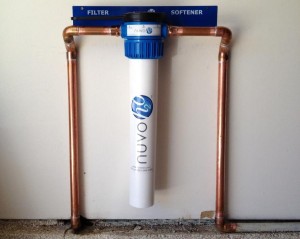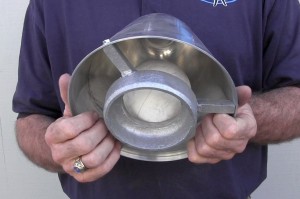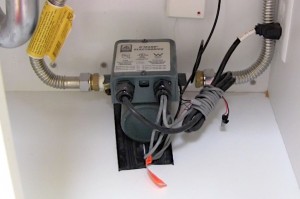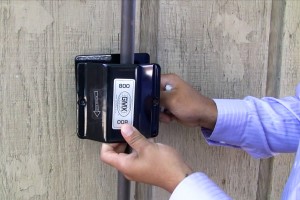
Thanks to industry innovation, today’s plumbing technology is able to provide sophisticated solutions for age-old problems. Photo: Savior Plumbing (2014)
Plumbing has been part of human civilization for a long time—even ancient Rome had sophisticated systems to facilitate water delivery and waste disposal. And while plumbing technology has continuously advanced over the years, development has never occurred more rapidly than in recent decades. Modern innovations have brought improvements in terms of energy efficiency and water usage, which in turn have created solutions to age-old problems. We asked four Diamond Certified Expert Contributors to talk about some of these plumbing innovations and how they can benefit today’s consumers.
Sewer line backup prevention devices: Myles O’Dwyer of Pipe Spy Marin, Inc.
Due to the concealed nature of a sewer system, problems often go unnoticed until a catastrophic situation occurs, such as a line backup in the home. While backups have been an issue as long as modern sewer systems have existed, there are now devices that prevent this unwanted occurrence.
One such device is called a Contra Costa valve, which is a mushroom-shaped fixture that’s placed at the mouth of a home’s outdoor sewer pipe. The valve utilizes a small plastic ball to create a “soft” seal of the pipe. In the event of a backup, the ball simply moves out of the way and allows the pipe’s contents to escape outside rather than inside the home.

A “Contra Costa” valve can spare your home from a catastrophic sewer line back-up. Photo: Pipe Spy Marin (2014)
Tankless water heaters: Albert Nahman of Albert Nahman Plumbing, Heating, and Cooling
With impressive benefits like instant hot water and reduced energy usage, tankless water heaters are one of the hottest products in the plumbing industry. However, like any plumbing fixture, they require ongoing maintenance in order to perform optimally. One proactive measure is to periodically clean your water heater’s cold water inlet filter. Due to the presence of debris in plumbing pipelines, inlet filter screens tend to become clogged over time, which can affect their calibration and cause them to display false error codes. By routinely performing this step, you may be able to avoid an expensive service call.

A hot water recirculation pump saves both water and time by providing instant hot water. Photo: American Ratings Corporation (2014)
Hot water recirculation pumps: Leigh Marymor of The Lunt Marymor Company
One of the most common sources of water waste in the home is waiting for hot water to reach a faucet or shower. One effective solution is to install a hot water recirculation pump. Activated by an on-demand motion sensor, the pump “recirculates” the standing water in the hot water line, rerouting it through the cold water line and returning it to the water heater to be used at a later time. At the same time, the pump pulls hot water directly from the water heater to the faucet or shower. Besides saving water, a hot water recirculation pump offers convenience by providing hot water to the point of use.

A ceramic magnet system offers a low-maintenance, eco-friendly way to alleviate the effects of hard water. Photo: Rayne Plumbing and Sewer Service (2014)
Magnetic water softeners: Yussef Nesme of Rayne Plumbing and Sewer Service, Inc.
While there are several methods for dealing with hard water, none is as simple, low-maintenance and eco-friendly as magnetic water softeners. Placed at strategic points in a home’s pipe network, these magnets actually break down the molecular structure of heavy minerals in the water, naturally softening while reducing mineral buildup on the insides of piping.
To learn more about plumbing innovations and read other helpful consumer tips, visit experts.diamondcertified.info.
7 Responses
Leave a Reply
You must be logged in to post a comment.

My favorite invention is probably the tankless water heater. I am not completely sure how it works, but the space saving is well worth it. If you live alone, a tankless water heater will be the perfect fit for you, if not, do not throw away that 100 gallon tank just yet, it is still the best solution for high capacity households and apartments. the space it takes up should not be an issue in those cases.
this was a really interesting read. I liked what you said about advances in water softener systems. It’s pretty interesting how a magnetic water softener can use magnets to break down heavy minerals in water and reduce mineral buildup in my pipes. That’s one of the problems that I have with hard water, so it would be nice to use a water softener that can not only soften my water, but also reduce some of the buildup inside of my pipes.
I have never heard of a hot water recirculation pump before, but it sounds so helpful! It feels really wasteful to let the water run before it gets hot enough to step in the shower. This would be the perfect solution to fix that problem. Can it be installed by a plumber using my existing pipes?
I’m glad that they have so many different devices to prevent plumbing problems. It really makes being a homeowner a lot easier. Even if there are any plumbing problems, you can call a plumber, and then you don’t even have to be the one to deal with it.
I have an old hot water heater that I want to switch out for a new one. It works fine, but I know that it will die eventually. On top of that, I am not moving any time soon. I just like the idea of getting more modern technology in my home. Should I go to all this expense for a new system when the current one still works fine?
I liked your tip to install a hot water re-circulation pump. You’re right about how waiting for the hot water in a shower to heat up can waste a lot of water. Having a device that can reroute hot water through the cold water line and return it to the water heater can help reduce a lot of water waste. I should try this in my home to save on the water that I use when showering.
For basement drains, there is a manual shut off valves that some homeowners just in case of a flood. when the water starts backing up, you simply close the valve before it has the chance to back up into your home. this of course is a sure way of preventing your basement from flooding, i the event of heavy rainfall.